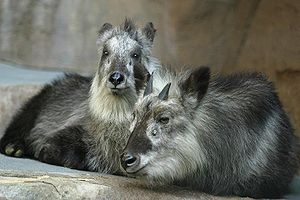Japanese serau
| Japanese serau | ||||||||||||
|---|---|---|---|---|---|---|---|---|---|---|---|---|

Japanese serau |
||||||||||||
| Systematics | ||||||||||||
|
||||||||||||
| Scientific name | ||||||||||||
| Capricornis crispus | ||||||||||||
| ( Temminck , 1845) |
The Japanese Serau ( Capricornis crispus ) is a caprinae mammalian species from the family Bovidae (Bovidae). He's in Japan (under the name Nihon-kamoshika ;日本羚羊) endemic and, together with five others, living also in East Asia species, the species of serow ( Capricornis ).
anatomy
Japanese seraue are similar in appearance to goats . They reach a head body length of around 130 centimeters, the tail is a short stub of around 10 centimeters in length and the shoulder height is around 65 centimeters. The weight of adult animals varies between 30 and 45 kilograms, with hardly any gender dimorphism between the sexes . Their fur is long and dense, the basic color is gray-brown or black. In contrast to the other serau species, however, it is not single-colored, but with speckled white hairs. The coat color is also regionally variable, so animals in the north of the distribution area are usually lighter in color. The legs are always dark brown or black, the throat usually white, which gives a “beard”-like impression.
Both sexes have short, slightly curved horns on their heads. These are around 8 to 15 centimeters long and around 3 centimeters thick at the base. The brown ears are long and pointed, the bridge of the nose is brown and hairless. Like all Seraue, Japanese Seraue have extremely noticeable scent glands located in front of the eyes. These secrete a secretion that smells of vinegar, which is used to mark territories.
distribution and habitat
Japanese Seraue live on three of the four main Japanese islands, Honshū , Shikoku and Kyūshū . Most of the specimens live on Honshū, where they can be found mainly in the northern and central parts. On Shikoku they occur in the southeastern part of the country and on Kyūshū they live in several smaller regions in the east of the island. Estimates of the total habitat in Japan are around 40,000 square kilometers.
Their habitat are primarily forested mountain regions up to 2700 meters above sea level, where they are mostly found in rugged areas with coniferous forests .
Way of life
The movement of the Japanese Seraus is rather slow and deliberate, but they are sure-footed even in rough terrain. To make better progress, they also create trails. These animals go looking for food especially in the early morning and late evening, the time in between they often spend in caves or under rock overhangs.
Japanese Seraue live mostly solitary, sometimes they are also found in pairs or small groups. They are territorial animals that defend their territory against same-sex conspecifics. The boundaries of their territories are marked with feces and with the secretion of their glands. The size of the territory depends primarily on the food supply, on average it is 1.3 to 4.4 hectares for individual animals and 9.7 to 21.7 hectares for groups.
nutrition
Japanese seraues are herbivores. Among other things, they consume grasses, buds, deciduous and needle leaves and acorns that have fallen to the ground.
Reproduction
Mating takes place in October and November. After about seven months of gestation, the female usually gives birth to a single young in late spring. This is weaned after five to six months, but remains in the mother's territory for two to four years. Sexual maturity occurs at the age of 2.5 to 3 years. The average life expectancy is around five years, the maximum age of these animals is around 20 years.
Japanese seraue and people
With the exception of the collar bears (who rarely hunt such large animals) and the wolf (which has been largely exterminated in the range of the Seraue), the animals have no natural enemies. Because of their fur and meat, they have been hunted by the people of Japan for centuries. At the beginning of the 20th century, the population had decreased so much that the species was considered threatened. In 1955 it was declared a Japanese "natural monument" and protected. The populations have since recovered, today the total number of this species is estimated at 100,000 animals. The IUCN lists them as not endangered.
literature
- Bernhard Grzimek: Grzimeks animal life. Encyclopedia of the Animal Kingdom. Bechtermünz 2001. ISBN 3-8289-1603-1
- Ronald M. Nowak: Walker's Mammals of the World . Johns Hopkins University Press, Baltimore 1999. ISBN 0-8018-5789-9
Web links
- Detailed information (English) and distribution map
- Capricornis crispus inthe IUCN 2013 Red List of Endangered Species . Posted by: Tokida, K., 2008. Retrieved January 22, 2014.